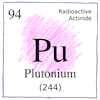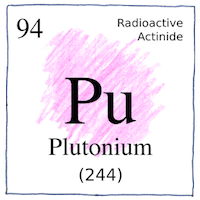Berkeley—Glenn T. Seaborg,
Arthur Wahl,
Joseph W. Kennedy,
Edwin McMillan
elements

|
Plutonium
In December 1940, Glenn Seaborg and his team made neptunium-238 in their cyclotron by bombarding uranium-238 with deuterons. Neptunium-238 decays, with a half-life of two and a half days, by negative beta emission leaving plutonium-238, which has a longer half-life— eighty-seven years and two-hundred seventy days— and is fissile—it easily breaks apart when hit by a slow-moving neutron, resulting in a nuclear chain-reaction as its neutrons hit other nearby plutonium atoms, releasing a huge amount of energy and radiation.
Atomic number 94
All isotopes of plutonium are radioactive. Plutonium-244 has a half-life of 80.8 million years. Plutonium-228 has a half-life of a little over a second. Plutonium-238 with its high decay heat powered spacecraft and landers.
Manhattan Project
The discovery of plutonium was kept secret until 1948. In December 1940, World War II had already begun. Franklin D. Roosevelt approved production of nuclear bombs in October 1941. Production of plutonium and uranium for nuclear bombs proceded concurrently. The X-10 Graphite Reactor at Oak Ridge irradiated uranium to produce plutonium. Facilities at Hanford separated plutonium from the uranium. B Reactor at Hanford produced plutonium for weapons used during the war.
P.U.
Glenn Seaborg said that their little joke—choosing the abbreviation Pu instead of Pl—was hardly noticed.



Seventy-one years have passed since the bombing of Nagasaki, 9 August 1945, where the plutonium bomb “Fat Man” killed 60,000 to 80,000 people.
Cleanup of radioactive materials at the Hanford Site, next to the Columbia River in the middle of the state of Washington, continues to be a problem.
See also in The book of science:
Readings in wikipedia:
Other readings: